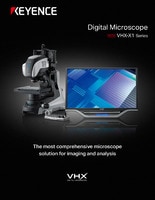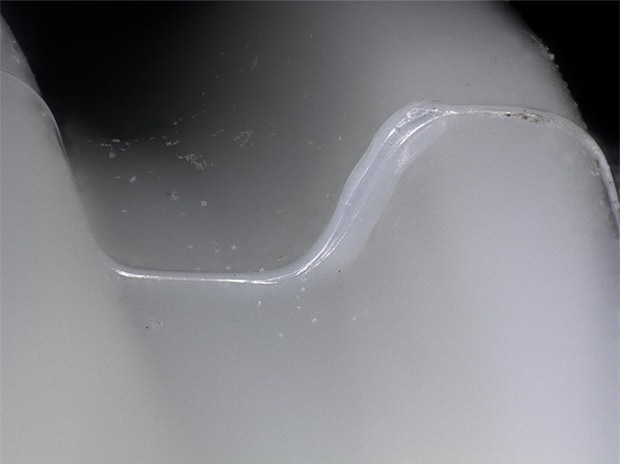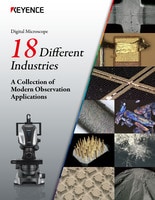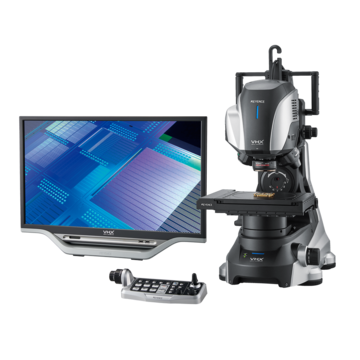Digital Microscopes
Observation and Measurement of PET Plastic Bottles Using Digital Microscopes
Most plastic bottles we use in everyday life are made from polyethylene terephthalate (PET), which is a type of resin made from petroleum. This material has been commonly used for beverage containers because it complies with the Food Sanitation Act and is safe, light, and highly recyclable. This section introduces the characteristics and manufacturing method of plastic bottles made from PET along with examples of how they are observed and measured using digital microscopes.
Characteristics of PET Bottles

Thanks to the following characteristics, PET bottles are widely used for beverage containers in everyday life.
- PET bottles are safe and sanitary, complying with the Food Sanitation Act.
- PET bottles are lighter and harder to break than glass bottles.
- PET bottles are recyclable, so they are eco-friendly.
- PET bottles change to carbon dioxide and water when burned, emitting no harmful substances.
- PET bottles can be capped repeatedly.
- The contents can be seen because PET bottles are transparent.
- PET bottles are easy to process and there are a wide range of sizes.
Get detailed information on our products by downloading our catalog.
View Catalog

PET Bottle Manufacturing Method
Typical PET bottles are manufactured with the biaxial stretch blow molding method as shown below.

1. Preforms, which are original tubular PET bottles used for creating PET bottles, are created by injection molding.

2. Preforms are heated to approximately 100°C (212°F).

3. Each preform is inserted into a bottle mold and then the mold is closed.

4. High-pressure air is blown into the preform to press it to the mold.

5. After cooling, the mold is opened and the PET bottle is removed.
We’re here to provide you with more details.
Reach out today!

Materials of PET Bottle Caps and Labels
Some recent PET bottles have no labels.
While PET sinks in water, PP floats. Consequently, these properties prevent them from being mixed with each other when recycled.
Bottles are made from PET, but their caps are made from polypropylene (PP) and their labels are made from polystyrene (PS). PET, PP, and PS are selected for the following reasons.
- PP caps easily contact tightly when closed because PP is softer than PET.
- PP is easy to process such as for threading and antiskid forming.
- PET labels are too hard to wrap around bottles.
We’re here to provide you with more details.
Reach out today!

Petaloid Shape
PET bottles for carbonated drinks, which are called pressure resistant bottles, always have circular cross-sections with thick walls.
Additionally, there are five hemispherical projections on the bottoms. These projections seem like petals, which is considered the ideal shape to withstand gas pressure.
We’re here to provide you with more details.
Reach out today!

PET Bottle Observation and Measurement Examples Using Digital Microscopes
These are the latest examples of observation and measurement of PET bottles using KEYENCE’s VHX Series 4K Digital Microscope.
Observation of an air bubble defect in a preform
Using the ring-reflection removal function enables observation with no glare.

VH-Z20, 50×, ring illumination, without ring-reflection removal

VH-Z20, 50×, ring illumination, with ring-reflection removal
Observation of scratches on a cap surface
Using the ring-reflection removal function allows for observation of scratches on cap surfaces.

VH-Z00, 5×, ring illumination, without ring-reflection removal

VH-Z00, 5×, ring illumination, with ring-reflection removal
Observation of burrs on a PET bottle opening
A large depth of field makes tilted observation easy.

VH-Z20, 20×, ring illumination

VH-Z20, 100×, ring illumination
Observation of cracked resin on a PET bottle bottom
Holes are easily made on thinner PET bottle walls when they are scratched or marked. The depth of scratches, holes, and marks can be measured during observation using a digital microscope.

VH-Z00, 10×, ring illumination
Image focused on the bottle head

VH-Z00, 30×, ring illumination
Image focused on the bottle bottom
A long working distance and a large depth of field allow for container observation without cutting.
Measurement of flaw depth on a PET bottle

VHX-E100, 100×, ring partial illumination
Measurement of marking depth on a PET bottle

VHX-E500, 700×, coaxial illumination
3D profile measurement of a label adhesive on a PET bottle

VH-Z20, 200×, ring illumination
Get detailed information on our products by downloading our catalog.
View Catalog




